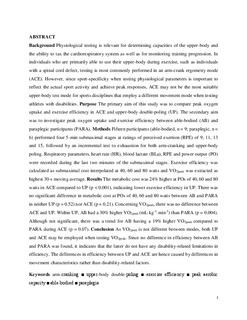| dc.description.abstract | Background : Physiological testing is relevant for determining capacities of the upper-body and the ability to tax the cardiorespiratory system as well as for monitoring training progression. In individuals who are primarily able to use their upper-body during exercise, such as individuals with a spinal cord defect, testing is most commonly performed in an arm-crank ergometry mode (ACE). However, since sport-specificity when testing physiological parameters is important to reflect the actual sport activity and achieve peak responses, ACE may not be the most suitable upper-body test mode for sports disciplines that employ a different movement mode when testing athletes with disabilities.
Purpose : The primary aim of this study was to compare peak oxygen uptake and exercise efficiency in ACE and upper-body double-poling (UP). The secondary aim was to investigate peak oxygen uptake and exercise efficiency between able-bodied (AB) and paraplegic participants (PARA).
Methods : Fifteen participants (able-bodied, n = 9; paraplegic, n = 6) performed four 5-min submaximal stages at ratings of perceived exertion (RPE) of 9, 11, 13 and 15, followed by an incremental test to exhaustion for both arm-cranking and upper-body poling. Respiratory parameters, heart rate (HR), blood lactate (BLa), RPE and power output (PO) were recorded during the last two minutes of the submaximal stages. Exercise efficiency was calculated as submaximal cost interpolated at 40, 60 and 80 watts and VO2peak was extracted as highest 30-s moving average.
Results : The metabolic cost was 24% higher at POs of 40, 60 and 80 watts in ACE compared to UP (p < 0.001), indicating lower exercise efficiency in UP. There was no significant difference in metabolic cost at POs of 40, 60 and 80 watts between AB and PARA in neither UP (p = 0.52) nor ACE (p = 0.21). Concerning VO2peak, there was no difference between ACE and UP. Within UP, AB had a 30% higher VO2peak (mL·kg-1·min-1) than PARA (p = 0.004). Although not significant, there was a trend for AB having a 19% higher VO2peak compared to PARA during ACE (p = 0.07).
Conclusion : As VO2peak is not different between modes, both UP and ACE may be employed when testing VO2peak. Since no difference in efficiency between AB and PARA was found, it indicates that the latter do not have any disability-related limitations in efficiency. The differences in efficiency between UP and ACE are hence caused by differences in movement characteristics rather than disability-related factors. | nb_NO |
